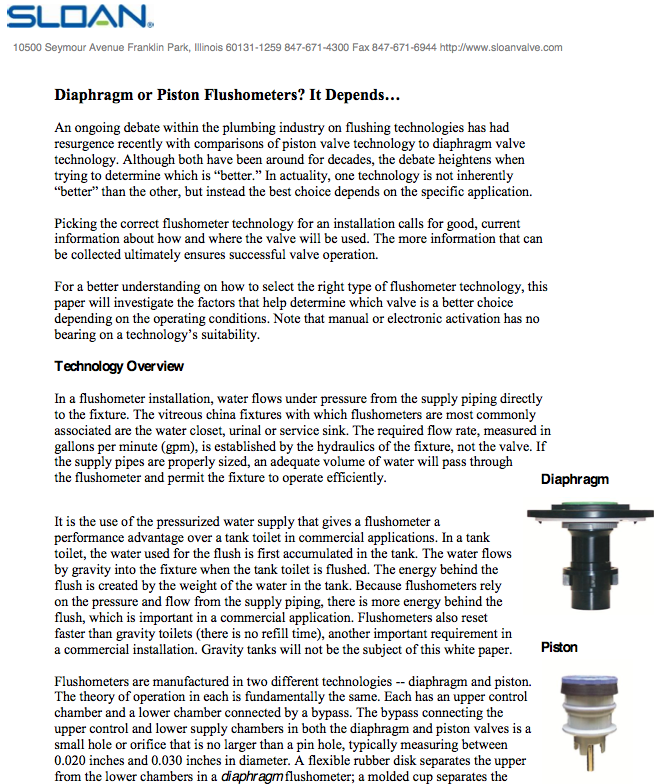How do you know when to choose diaphragm vs. piston flushometer valve technology? Sloan has issued a new white paper that discusses the differences between diaphragm and piston valve flushing technologies and includes charts that show under which operating conditions to specify one type over the other.
“Diaphragm and piston flush valves each have their strengths and are best suited for different environmental conditions,” says Mike Gipson, Flushometer Product Line Manager for Sloan. “It’s important to assess the environment before choosing to install diaphragm or piston technology.”
In addition to illustrating the mechanical differences between diaphragm and piston flushometers, the white paper highlights considerations that impact which type of technology is most appropriate for various restroom environments, including:
- High or low restroom traffic
- Water quality, including the pH of the water and chlorine concentration
- Operating conditions, such as high or low water pressure systems
Sloan invented the diaphragm flush valve more than 100 years ago and then introduced piston valves about 20 years later. Today, Sloan manufactures both diaphragm and piston flush valves in sensor-activated and manual models. Diaphragm flushometers include the Royal, UPPERCUT, Regal XL and Sloan brand valves; the Crown and GEM•2 valves are piston operated. Sloan offers flushometers for every type of environment from normal restroom applications to extremely harsh water conditions.
To help you determine which type of flushometer valve is best suited for the variety of restroom environments, download a PDF of the “Diaphragm or Piston Flushometers? It Depends...” white paper at http://www.sloanvalve.com/Water_Efficiency/SLV3583-Diaphragm_Piston_White-Paper.pdf. BD+C
Related Stories
Architects | Mar 11, 2016
German artist recreates Brutalist buildings with LEGO blocks
Arndt Schlaudraff brings the beauty out of the rugged, linear style of buildings most popular a half century ago.
Architects | Mar 11, 2016
Architecture for Humanity rebrands itself as Open Architecture Collaborative
With a new name, logo, and mission, the Open Architecture Collaborative is seeking a fresh start.
Architects | Mar 11, 2016
AIA survey finds many women and minority architects still feeling underrepresented and unfulfilled
Dissatisfaction with “work-life balance” and compensation are cited as reasons why companies’ diversity strategies may be faltering.
University Buildings | Mar 11, 2016
How architects can help community colleges promote community on campus
Even in the face of funding challenges and historic precedent, there are emerging examples of how partnership between two-year academic institutions and designers can further elevate community on campus. CannonDesign's Carisima Koenig has a few key examples.
Architects | Mar 10, 2016
Value engineering: How to manage the process and limit the risk of VE
AEC consultant Steve Whitehorn shares several ways in which architects can be more effective managers of value-engineered change.
Architects | Mar 9, 2016
Two Houston firms merge to form Method Architecture
In mid-2016, Architects-Plus and Three Square Design Group will join to make a studio that will design industrial centers, corporate interiors, breweries, and more.
Hotel Facilities | Mar 7, 2016
Exclusive villas and spa in China will be built at the center of a lake
The only connection between the complex and the mainland will be a narrow pedestrian bridge.
Office Buildings | Mar 2, 2016
HDR redesigns Twin Cities' studio to have coffee shop vibe
With open spaces, huddle rooms, and a design lab, the firm's new digs are drastically different than the old studio, which felt like working in a law office. Design Principal Mike Rodriguez highlights HDR's renovation plan.
Architects | Feb 25, 2016
12 architects selected for 2016 AIA Young Architects Award
Winners include Amy Kalar and Karen Lu, both with HGA, BNIM's Carey Nagle, and MSR Design's Bob Ganser.
Architects | Feb 24, 2016
Is the booming freelance economy a threat to AEC firms?
By shifting the work (and revenue) to freelancers, “platform capitalism” startups have taken considerable market share from traditional businesses.

















